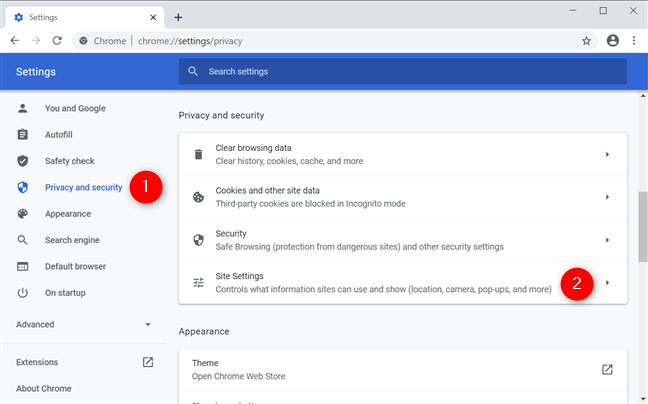

If you spot a website you don’t want to receive notifications from, click on the three vertical dots button to bring up an “Options” submenu. This is where you can disallow specific websites from sending you prompts and pop-ups.īy scrolling down to the “Allowed to send notifications” area, you can view what websites are actively sending you prompts.

Doing this poses the benefit of only letting your preferred content appear on the screen, not notifications you probably don’t have anything to do with.Īfter arriving at the last section in the previous subtitle, where you disable sites from sending notifications, scroll down a little to reach the “Customized behaviors” area. Disable notifications of specific websitesĪs opposed to the method outlined above that removes notifications from the Chrome browser, you can also tweak Google Chrome to block notifications from particular websites. Let us get on with the article and show you another way you can pull off the same trick. That’s about it for the first method of disabling Chrome notifications. Check out the following screenshot to complete the step in question.Ĭlicking on “Don’t allow sites to send notifications”

The first step is to open the Chrome browser and access its “Settings” from the “Customize and control Google Chrome” button.
STOP GETTING GOOGLE CHROME NOTIFICATIONS HOW TO
The following steps will take it from here and guide you on how to do this painlessly.ġ. It will also apply to those sites whose notifications were personally enabled by you. No website can send you any notification after enabling a specific toggle in the Chrome browser. Disable browser-wide notificationsĪ quick and easy way to get rid of notifications in Google Chrome is to disable them browser-wide. Let’s take a close look at these methods so you can quickly learn how to turn off these pop-ups in Chrome on the fly. Both of them are easy to follow through and result in successful results. It turns out that there are two different methods you can use to disable notifications in Google Chrome. The best ways to disable notifications in Google Chrome Let’s talk about how you can avoid these occurrences and manage them at will, similar to Google Chrome extensions permissions. Your privacy can be risky if you allow too many websites to send notifications. That is why one must know how to control these intrusive features. While this Chrome feature certainly has its advantages, there’s no doubt that these pop-ups can often get annoying as well, especially when you didn’t sign up for them in the first place. In addition, notifications are meant to provide the latest updates on a site, so all its followers can stay up to speed with everything trendy across the niche that the website targets. This attempts to draw traffic toward the website by sending these notifications out. Now, notifications are sent out by various websites that you visit when you’re using Google Chrome. They are usually small in size, arising out of the specialized notification area or the status bar of the interface. Open Chrome>3 dot menu>settings>site settings>notifications>choose. Notifications in Google Chrome have dedicated pop-ups that appear on the desktop of your device’s operating system. Looks as though youve inadvertently given permission to that site to send you notifications. So let’s jump right in without wasting any further time. That is why we’ve decided to put together this guide to show aspiring users the exact method they can use to make browsing on Google Chrome and their respective devices much more seamless. In such scenarios, you should know how to turn off Google Chrome notifications for the better and resume your browsing swiftly. For instance, some websites will often start sending you notifications that don’t matter to you. In some cases, the browser comes across as more annoying than helpful, so we have to keep in check what functionality is beneficial for us and which one has to be toggled off promptly. Write-Information "URL List Item : $($urlObj.name) / $($urlObj.With that being said, however, not every piece of functionality that Google Chrome boasts is certain to be productive and valuable. $install = Get-ItemProperty $regKey -name $number -ErrorAction Stop Write-Information "Created Reg Key $regKey" $regKey = "HKLM:\SOFTWARE\Policies\Google\Chrome\NotificationsAllowedForUrls"

Write-Information "Allow Notifications for $url" Therefore, you would need to remove the parameter section and replace it with a static URL. Similar to our previous example with Extensions, if you want to deploy this with Microsoft Intune, scripts do not accept parameters. Second, and a little more involved, a script to add on site exceptions. Disable Chrome notifications with PowerShell


 0 kommentar(er)
0 kommentar(er)
